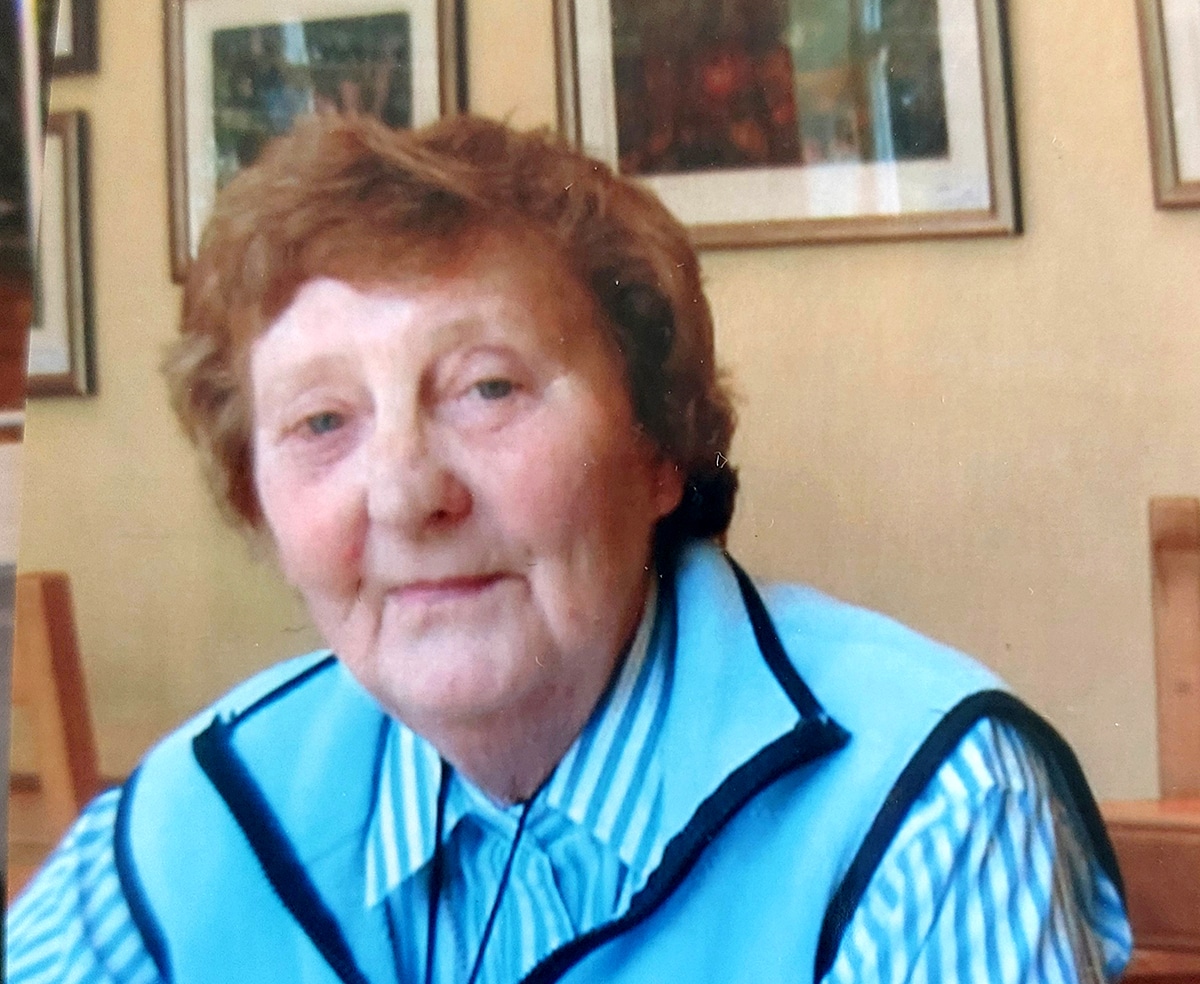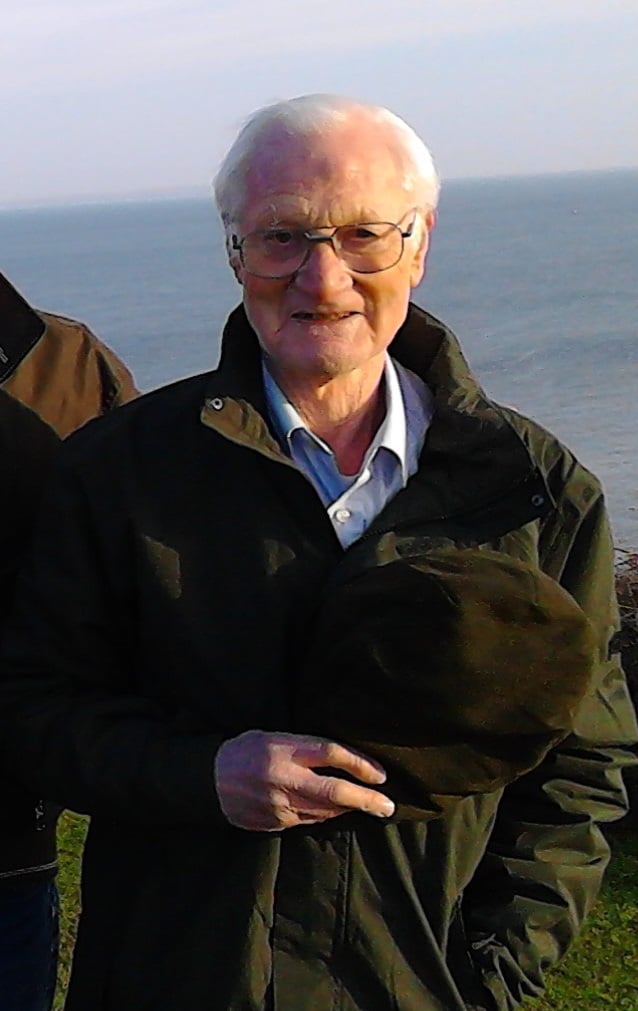 |
| Colin Greenhalgh, Boxing Day 2015. Photograph courtesy of the family. |
22.07.1931 – 19.12.2022
Colin Greenhalgh died on 19 December 2022 at the age of 91. He was the Secretary of Hampstead Hockey Club (before it became Hampstead & Westminster HC) for an unprecedented term of 11 years until 1971, in the days when that post covered virtually the entire administration of Club affairs.
As the Club grew and prospered in later years and in particular after its move to Paddington Recreation Ground (that brought with it the consolidation of a women’s section and greater success on the pitch) there is no doubt that this came about, in no small measure, through Colin’s dedication to the Club in earlier years and his remarkable leadership and other attributes.
Colin was a true gentleman in everything he did. He always had a smile. Almost single handedly, he navigated the Club through troublesome times at Hornsey (a north London district in the London Borough of Haringey), with frequently waterlogged pitches at Tivoli Road. This was combined with comparatively poor match results and when morale was often at a low ebb. Colin was found frequently engaged in struggles with the Hornsey Club, whose ground it was and whose cricket members were generally reluctant to expend funds in improving the playing surfaces in winter. The negotiations of tenancy agreements for the Club’s use of the ground in winter tended to be afflicted with the same sensations of quagmire.
Childhood and education
Colin was an only child, born on 22 July 1931 in Stockport to Harold Greenhalgh, who worked behind the counter in Boot’s, and Marjorie Batt, who suffered from rheumatoid arthritis and was wheelchair-bound for most of her life.
During his primary school years, Colin and his parents left Manchester under the threat of bombing in World War 2. He was evacuated to Blackpool, where he lived for a number of years with a couple he had never met before – he went from being an only child to being a solitary child without even his parents. Prompted by the experiences of Manchester during World War 2, his parents then moved in 1942 to the most remote place they could find – Holyhead on Anglesey.
Colin had just turned 11 and had been hoping to attend King Edward’s Grammar School in Manchester. The move put this out of the question. He was unable to be admitted to the local grammar school, Rhyl GS, but did obtain a place at St Asaph GS. That involved at least a 1.5-hour journey by bus and train. Peter Macauley-Owen, the Head Teacher and Maths Teacher at the school, spotted Colin’s mathematical abilities and prepared him to enter for a scholarship to Oxford University – which he achieved.
Career
His solitary childhood made him fearless of adventure. Having finished his exams one summer, he took off by his motorbike to Wimbledon, to see if he could get a job, which he did – updating the manual scoreboards at the All England Lawn Tennis Championships.
After graduating, Colin went into the world of market research. He worked for the British Market Research Bureau, SmithKline Beecham and Taylor Nelson. In 1973, he set up his own market research company – Product Testing Research. This allowed him to carry out pure research, as well as commercial projects.
In one piece of work, he purchased many boxes of small soap samples – all smelling exactly the same. He labelled them with different codes and then asked members of the public to smell them and indicate which smell they preferred. He wanted to understand the innate bias that people have for some letters over others – the obvious being A over B or X over Y – but there were also other less obvious and product related preferences. For example, the letter P always came out very well and Colin concluded this was down to an assumption that people were smelling a Pears soap.
Through this project he managed to find codes for putting on samples that would not have any built-in bias. He was also the first person, in this country at least, to develop exit polls and conduct them in a way that would properly represent the electorate across the country.
Colin received two gold medals from the European Society of Market Research for his work.
Sporting and recreational pursuits
At Oxford University, Colin played tennis and hockey for Jesus College. He kept them up afterwards – hockey in his younger years and tennis when he became older. With tennis initially at Teddington Tennis Club and later at what started as informal tennis at Carlisle Park and then Hampton School, Colin became involved in the administration, introduced structure and demanded standards, especially over notifying him of attendance.
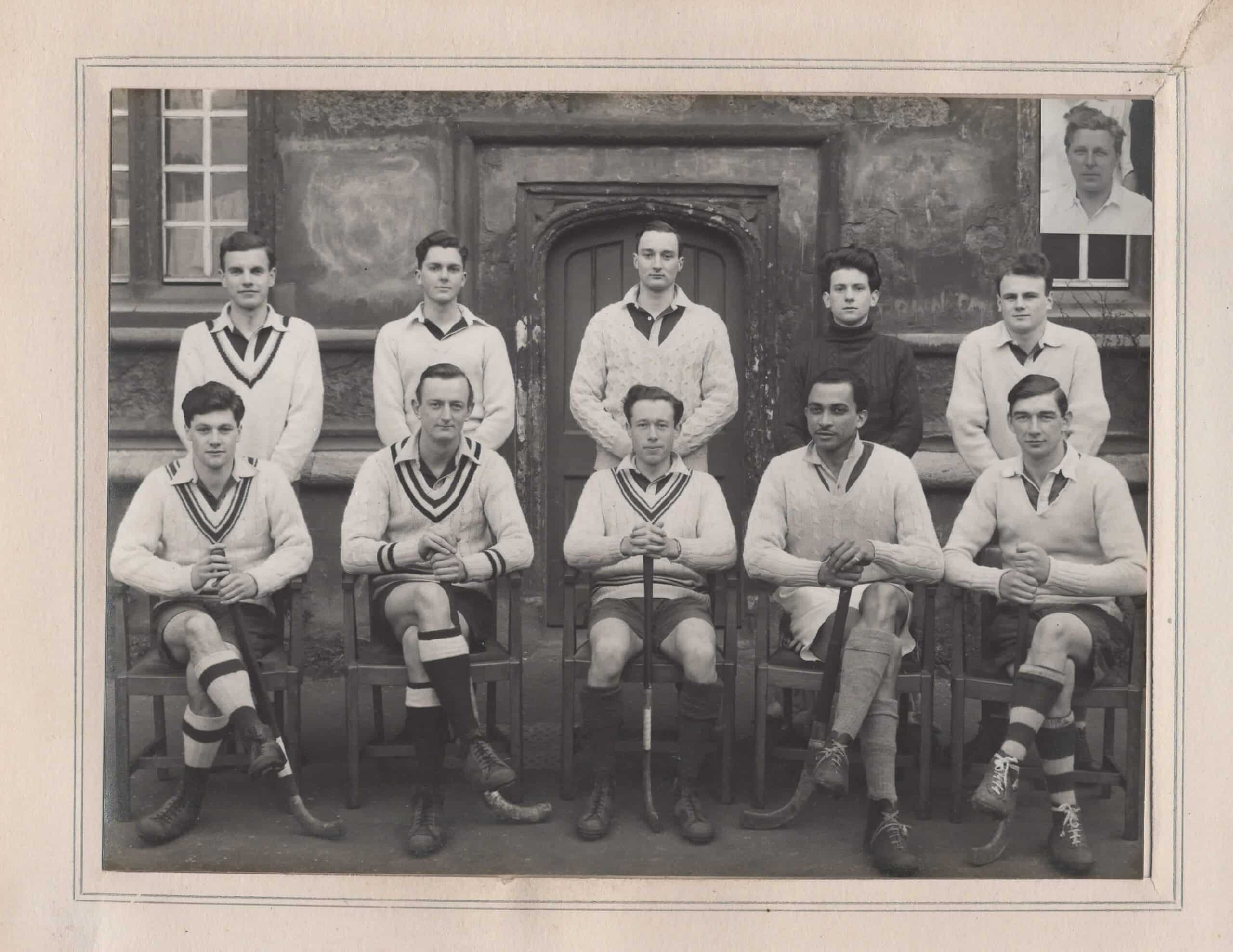 |
| Jesus College Hockey Club, Oxford University: Colin is seated far left as viewed from the camera. Photograph courtesy of the family. |
He took a similar approach to the amateur dramatics – taking over the running of committees. His love of amateur dramatics took over once he became less able to run around a pitch. Colin became increasingly involved and requisitioned his own house as a rehearsal room and for making props.
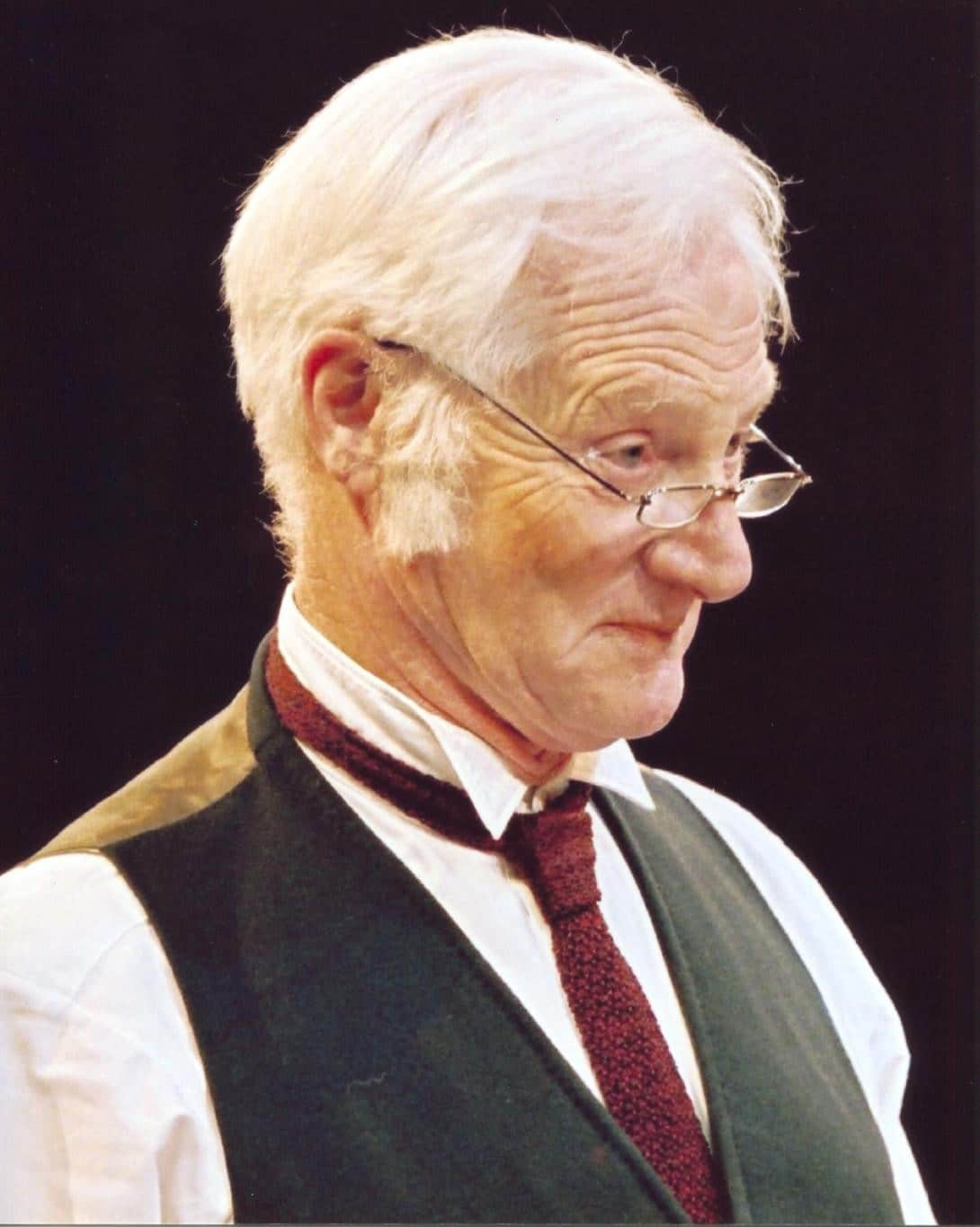 |
| Colin in the play Charley’s Aunt (where he played the character Brassett), with Teddington Theatre Club. Photograph courtesy of the family. |
On his move to Cornwall to be closer to his daughter Sally, Colin enjoyed going to Tideford Cricket Club to watch one of his grandsons play cricket and to Lux Park in Liskeard to watch the other playing hockey for the Caradon Hockey Club. Several spectators at Caradon HC are now probably more conversant with Hampstead Hockey Club than their own club.
Of Colin and Hampstead Hockey Club
Colin was elected a member of Hampstead Hockey Club on 14 November 1955. He was a moderate hockey player, predominantly a half back in the 3rd XI, alongside John Chaumeton, who captained the side in the early 1960s. Sometimes Colin was called up to the 2nd XI – for example against Honourable Artillery Company (HAC) on 10 March 1962 – and was happy to drop down a team (such as agreeing to play for the 5th XI against Cheam on 27 October 1963 and to be a reserve for the 4th XI on 30 January 1966) when the need arose. He frequently volunteered as an umpire, conscious of the few that were willing to officiate. In October 1962, facing the usual initial enthusiasm generated by the optimism of a new season, the Club ran a Wanderers XI, in effect a sixth team and Colin played for them.
Under John Chaumeton, the 3rd XI went undefeated in the 1962-63 season at Christmas, with six wins and three draws, scoring 29 goals and conceding 15. This run could not be sustained however and a rude reminder was given by St Albans, who won 7-0 on 31 March 1963.
On 7 October 1957, Colin was appointed 3rd & 4th XI Secretary and became a member of the Club’s Committee upon taking up the post of Assistant Hon. Secretary to Hugh Wickham, having been proposed by Morley Pecker at the Annual General Meeting (AGM) on 11 April 1958. He was busy straightaway, eager that something should be done about recruiting good College players to the Club for the forthcoming season. He also encouraged the formation of a 5th XI.
On 1 April 1960, Colin was appointed Hon. Secretary, in succession to Hugh Wickham, who was thanked at the AGM “for five difficult years”. Hugh agreed to act as Fixture Secretary and Colin found further support from a trio of respected members, Stan Elgar as Treasurer, Noel Cardoza as captain of the 1st XI and Hugh Avey as Match Secretary. Together they sought to revive the days of the mid 1950s when the Club had so rapidly restored its playing fortunes after it was re-formed in 1951.
Almost immediately, Colin became involved in the search for additional pitches, especially if the Club was to expand with the formation of a fifth team. On 8 December 1960, he reported to the Committee that he was pursuing an extra pitch at St Aloysius’ College and had made contact with Finchley Borough Council, Hornsey Borough Council, the London County Council and J F Lyons Sports Club to seek an additional ground. The only positive response was from London County Council that offered space at Victoria Park in Hackney.
Colin was prepared to risk favour by his suggestion of introducing a match fee, to cover the cost of teas, the post-match shandies and the first round of the beer kitty. The other members of the Committee were less than enthusiastic and regarded it as undesirable, suggesting instead that the responsibility for covering such matters should be left to team captains.
In March 1961, Colin agreed to act as Team Secretary for the Spaniards, then the Sunday team of mixed ability that usually toured to play varied opponents, not necessarily in the immediate vicinity. Colin was a significant supporter of the Spaniards and later, with Hugh Wickham, of the Puritans HC. As Secretary, one pleasure at the time was to convey the Club’s congratulations to Jim Deegan upon his selection for England.
In January 1962, Colin devised the Club Bulletin, intended to notify members of team selections, replacing the postcard system that had operated for a few years. It would also provide an opportunity to relate current news of the Club. In the first edition he set out his thoughts:
“This bulletin comes to you by way of an experiment … This could have several advantages, not the least of which, I hope, will be that you will have a much clearer idea of where not only your own team but also the whole club is going from week to week, who is winning and who is losing, who is being promoted et cetera. And it also provides a useful vehicle for getting odd snippets of news to you which do not warrant a circular of their own. I hope I shall be able to make this bulletin business work: if you have any suggestions for improving it (without adding to the workload involved) please let me know.”
This set in train a sequence of Bulletins that were continued in regular form throughout Colin’s stewardship and continued by Richard Shaw, Dave Teale and Norman Borrett, before they began to decline in influence.
Colin was also a supporter of the Spaniards on their visits to the National Physical Laboratory (NPL) Easter Hockey Festival at Teddington, when the Spaniards B XI represented the Club. Colin took part in at least four consecutive events.
Some of the most challenging aspects of Colin’s tenure were his dealings with the Hornsey Club. The state of the grass pitches in winter bedevilled the Club for almost 30 years before artificial surfaces began to appear and ease the burden. The cricketer members of the Hornsey Club tended to benefit from the dry conditions of the summer, possibly unaware of the adverse effects of autumn rains and the underlying London clay geology in autumn and winter months. Or, if they were aware, they were ill prepared to accept a burden of expenditure to make the grass pitches usable in winter. It may have been an unwillingness to accept interference in the maintenance of the ground for the summer’s cricket.
The Club had moved to Hornsey after a few torrid years of finding a home ground in the mid-1950s and was eager to establish something a little more permanent. As an example of the rather awkward dealings with the Hornsey Club that were to predominate affairs for the next few years, in November 1962, Colin reported to the Committee his correspondence and conversations with the Hornsey Club officials since the preceding August.
These were to the effect, first, that the Club was to be given notice to leave the Hornsey Club at the end of the current season because of the continuing deterioration of the outfield but, second, (and rather mercurially) because a full-time groundsman had been appointed and had started work, this notice was withdrawn. Instead, the Hockey Club’s tenancy was assured to the end of the 1963-64 season (at the existing rent of £150 for the season but to be renegotiated for 1963-64) and then to be reviewed in the light of the state of the outfield. After discussion about this and the long-term future, the Hockey Club’s Committee agreed to offer the previous negotiated rent of £175 for that season and to ask the Hornsey Club to meet a negotiating Sub Committee to discuss next season and thereafter.
In light of the threat of eviction, the Sub Committee began to explore other options. One that was negotiated at some length was to play at The Oval Cricket Ground. In February 1965, Colin reported that Surrey County Cricket Club had finally rejected the Club’s application, despite the intervention of Cyril Wilkinson, CBE, a former Hampstead Hockey player and 1920 Olympic gold medal winner, who had also captained Surrey CCC.
Colin added that the Sub Committee had carried out an extensive search of North London, which had not been very encouraging. Many other grounds large enough already accommodated football or rugby. There were one or two possibilities, including Finchley Cricket Club and South Hampstead Cricket Club. It was agreed a 12 months’ extension at Hornsey would help in investigating these possibilities thoroughly. Colin was asked to approach the Hornsey Club accordingly but, in the meantime, the Sub Committee was given freedom to make other approaches felt desirable.
In November 1966, Colin was able to report that a five-year Agreement had finally been exchanged with the Hornsey Club. The promised perimeter drainage was due to be installed within a week or so. However, that good news was rather quickly dissipated, as frequently seemed to be the case.
As a grant from the Ministry of Education was now unlikely to materialise for a year, the Hockey Club would need to fund the £50 balance of the cost of the drain. At least turf had now been laid on the second pitch extension to make possible its enlargement for viable hockey in the new year. Frustratingly, it was believed that the Hornsey Club had increased the price of teas to 2/6, contrary to the recently signed Agreement (in which prices were quoted at 2/-). The Hockey Club had reluctantly agreed that if this price increase were confirmed, the Hockey Club would need to ask for lower quality teas to sustain the price of 2/- in order to keep the matchday kitty within its previously accepted level. However, in view of the likely £50 (for the perimeter drainage) it was agreed the Hockey Club ought not to run a deficit again. It therefore accepted the need to raise the matchday kitty to 7/6 per game, leaving 3/- per game as a contribution to club funds.
In September 1969, Colin reported to the Committee his discussions with the Hornsey Club over the Hockey Club’s request to renew the mole drainage beneath the playing surface. The groundsman was reported to be resolutely opposed, as he reckoned that it could not be done by him at economic cost. Colin felt that this advice had to be accepted, provided the groundsman agreed to explore how the renewal could be carried out economically next year. Unabashed, the Hornsey Club then demanded a contribution towards the estimated cost of £40 to fertilise the ground that autumn. The Hockey Club agreed not to accede, given the Hornsey Club’s contractual obligation to provide adequate hockey pitches. Instead, it was agreed to try to purchase a self-propelled spiker that the groundsman felt would be valuable (even if providing it might exceed the budget of £100 set by the Hockey Club).
Perhaps the best example of the tortuous nature of the negotiations is the summary provided by Colin to the Committee on 1 June 1970. At a meeting with the Hornsey Club representatives, it had been agreed:
- To enter into a contract with Sherwoods for ploughing, levelling and re-seeding one half of the outfield in the coming autumn;
- To instal the necessary land drains for effective mole drainage at the same time;
- To provide mole drainage equipment and a suitable tractor for moling this autumn and whenever necessary later; and
- To plough, level and re-seed the other half of the outfield in the following autumn, or as soon as the first half was ready to accommodate hockey again.
The Hornsey Club had also agreed a method of financing these works that would involve:
- The Hockey Club contributing £500 to the total estimated cost of £1,300;
- The Hockey Club extending a loan to the Hornsey Club by putting up an initial £600 of the £900 investment that autumn;
- The Hornsey Club granting the Hockey Club a ten-year tenancy, of which the first five years’ rent would be £400 (for winter and summer play) and the remainder of the term at a “slightly higher” rent, to be agreed; and
- The loan to the Hornsey Club to be repaid by a rebate in the first five years’ rent in the order of £110 per annum.
In addition, while only one pitch was available at Hornsey, the rent would be reduced by the cost of hiring a replacement pitch (but at the cheapest rate, for the benefit of the Hornsey Club). Colin understood that the Hornsey Club Committee has agreed this outline proposal (including that of the Treasurer regarding the capital expenditure) and on that basis it was also approved by the Hockey Club’s Committee.
On 6 August 1970, Colin was able to report that the order for the groundworks, agreed with the Hornsey Club and recorded in the Minutes, had been placed. However, he then learnt that the Hornsey Club had (apparently without notice) sought the advice of the Bingley Sports Turf Research Institute, who had advised that sub-soil cultivation and heavy sanding would provide better drainage than mole drains, though their recommendation on the quantity of sand would involve considerably higher cost. As a result, it was recognised that a further meeting was needed with the Hornsey Club to agree a revised scheme – provided the cost of the sanding would be similar to the amounts in the original agreement.
Colin also had a pivotal role in agreeing the date of the Club’s 75th anniversary in 1969 and how it should be celebrated. Odd though it might seem, the anniversary date was in some doubt, with suggestions that it should take into the account the start of hockey played as a section of Hampstead Cricket Club, which, at its latest, was in 1890 – and not the date when the hockey players seceded from Hampstead Cricket Club in 1894 to form their own hockey club.
To mark that anniversary Colin wrote and published Hampstead Hockey Club 1894-1969: A Short History (pictured) drawing upon archive material that had been passed to him as Secretary (and that at one time was thought to have been lost). Its 41 pages include a succinct narrative of the 75 years, a tailpiece containing the reminiscences of former players and members Jack Bennett, Ruari Milsted and John Sankey, as well as schedules listing representative honours, administrative honours and the officers of the Club.
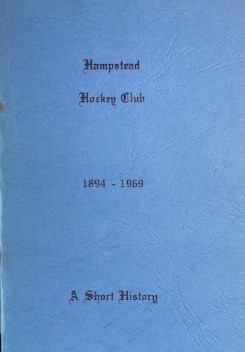
A postscript to book added:
“The best works of scholarship always have a contribution by that well-known busybody, Another Hand. This one is necessary to point out a grave omission. The lynchpin of Hampstead Hockey Club for the past decade is someone who has barely received a mention in this otherwise excellent history. Colin is coming up for his tenth year as a devoted and indefatigable Honorary Secretary. The amount of time he gives to Club affairs is heroic. His annual intervention at the Club Dinner, if not always printable, is a highlight of the London season. No one in the last 75 years has deserved the praise and thanks of members more.”
Another significant achievement for Colin was in persuading Peter Boizot to join the Club when he enquired in 1967, having been rebuffed by two other leading London clubs. That connection was something that Peter frequently mentioned and made evident the respect that he had for Colin. Peter’s benevolence to the club and hockey (and things Peterborough related) has become the stuff of legend.
Colin retired as the Secretary of the Club at the AGM on 1 April 1971. The Chairman, Jeremy Potter announced that on Colin’s retirement after 11 years in office, he, the Vice Presidents and members wished to mark their appreciation by the presentation of a pair of decanters. The minutes read, “Mr Greenhalgh, who was specifically instructed by the meeting to minute these sentiments, coupled with gratitude to Mrs Greenhalgh for her tolerance, thanked the club for the elegance and totally unexpected munificence of their gift and, in outlining the achievements (and some of the minor disappointments) of the Club’s last 11 years, said that the pleasure of serving such an admirable membership had been reward enough in itself.”
Colin did agree to remain a member of the Committee, which he did until standing down in 1974 at the same time as Peter Boizot; in the latter’s case as he was about to launch a campaign to become a Member of Parliament for Peterborough.
In later years, Colin was instrumental in maintaining a dialogue between the club and its former players and members, especially through his regular newsletters to those he called Old Members or OMs. He was already on hand to include past Presidents and stalwarts when in poor health and to pay them visits to boost morale. In March 1989, after the death was announced of John Sankey, renowned as one of the three who managed the Club’s revival in 1950 after the dispersal of members at the end of World War 2, his daughter discovered two whistles that John had used and donated them to the Club. They were mounted and framed by Colin and presented to the Club. Colin requested that they be named the Sankey Siffleurs and awarded for some extraordinary commitment to umpiring in the Club.
The Club tended to turn to Colin for anecdotes. One of the more entertaining was of the events that gave rise to the dents in the original Barnard Cup – a Club trophy awarded to the captain of the side with the best playing record each season. These dents came from it hitting the tarmac when deliberately thrown from a car at speed on the A3 Kingston By Pass by a disgruntled non player, fed up with the disproportionate attention given by the other occupants to hockey. Soon after the same Barnard Cup was stolen in broad daylight from the Carlton Tavern, an insurance claim was successfully made, despite there being no photograph of the Cup. Colin made a sketch drawing of it from memory, which proved sufficient to support the claim.
Colin was also a significant contributor to the debate over the expansion of Vice Presidents of the Club, promoted at the time by Peter Boizot. Colin provided a valuable oversight and measure of proportionality, conscious of the roles of past Vice Presidents when far fewer in number. He encouraged the formation of cohorts of similar aged former players in four distinct groups, conscious of the differing experiences of the Club within those age groups and for the better (or more informed) understanding of how to communicate with them.
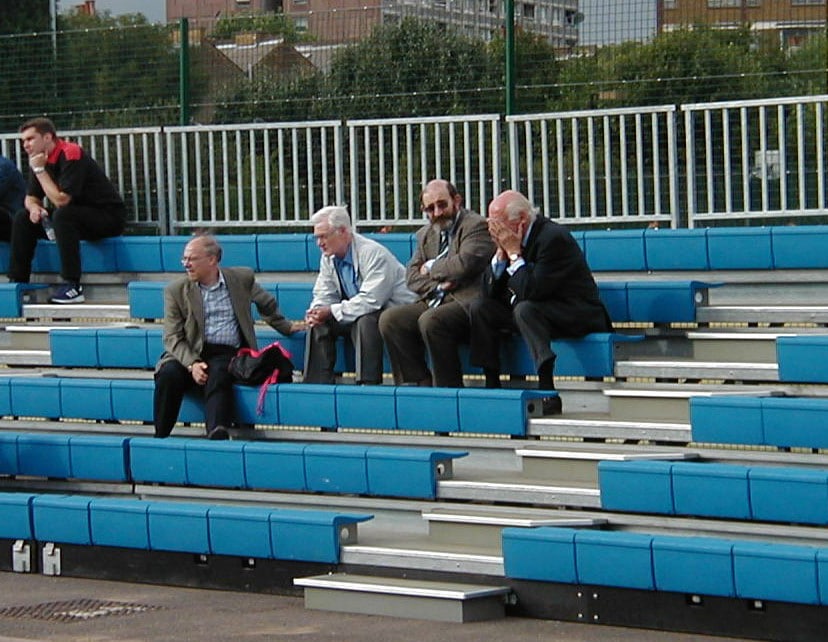 |
| Hampstead & Westminster Hockey Club Vice Presidents. Seated centrally, from left to right: Anthony Swing, Colin Greenhalgh, Alan Kurtz and Peter Boizot. Photograph courtesy of Ian Smith. |
Colin’s Passing and Funeral
Colin moved from Hampton to Liskeard in Cornwall in 2016. His daughter reported that her father died peacefully in his sleep on the night of the International Federation of Football Associations (FIFA) World Cup Final, having enjoyed the evening watching the victorious Argentina, the team he had favoured to win. His funeral was held on 14 January 2023 in Hampton, where his ashes and those of his wife were scattered on the Thames at the end of the road where they had lived for many years.
By Ian Smith,
Hampstead & Westminster Hockey Club Historian.
Explore the incredible website dedicated to the Club’s history and heritage: Hampstead & Westminster Hockey Club: through the years | hwhockey.co.uk
Sources
- The Minute Books of Hampstead Hockey Club 1954-1975.
- Bulletins of Hampstead Hockey Club, ed. Colin Greenhalgh.
- Personal recollections of Sally Daulton.
- Hampstead Hockey Club 1894-1969 – A Short History by Colin Greenhalgh.
- Website hwhockey.co.uk (The Registry of Hampstead & Westminster HC).
- Hockey News magazine.



